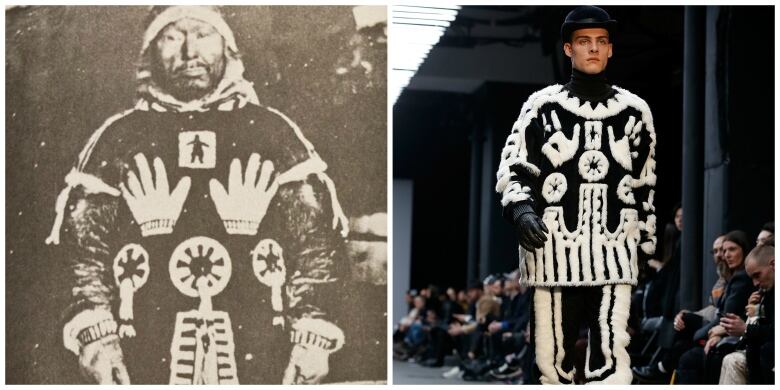Indigenous culture not protected in Canadian law, lawyers and academics say
'Indigenous heritage is often seen as a public domain, free for the taking'

As a young Dene girl, Muriel Betsina says traditional medicine saved her from being horribly disfigured.
It was winter and her family was living at a bush camp in the Sahtu region of the Northwest Territories just south of the Arctic Circle. While cooking caribou ribs, Betsina spilled boiling water down her arms.
She saidher mother melted spruce gum, a sacred medicine of the Dene people, and spread the sap onto a cloth, which was then wrapped around Betsina's burns.
"You don't see no scar, eh?It was right here. That's how powerful it is."
So powerful and sacred that Betsina saidshe'd give her life to protect it from exploitation.
"It's been here since God made it, since God made us."
Appropriation rampant
Companies around the world are mass producing salve made of spruce pitch or spruce gum and selling it for as little as $5 a jar.
Under Canadian law, protecting Indigenous traditional medicines, knowledge and cultural expression designs, dances, stories, namesfrom being exploited maybe more difficult than it seems.
Indigenous cultures in Canada have been appropriated by clothing designers, corporations and sports teams for decades. Some of those have made millions of dollars by selling Indigenous designs, names and ideas without consultation or any type of payment.

In 2015, U.K.-based fashion label KTZ made headlines after its fall men's collection included a number of garments based on traditional Inuit designs including a sweater that appeared to be a replica of an Inuit shaman's jacket. The fashion label later apologized and pulled the jacket from its stores. It said it was trying "to encourage appreciation for traditions, ethnicities and religions'diversity."
Not public domain but difficult to protect
"The problem is that Indigenous heritage is often seen as a public domain, free for the taking," saidGeorge Nicholas, a professor at Simon Fraser University who led an eight-year international research project on cultural appropriation.
"That's not the case. [For] many First Nations, many Inuit and other Indigenous peoples, their heritage is still vibrant.... When it is threatened, when it is used by others in ways that are inappropriate or unwelcome, this can cause a variety of harms, not just economic but spiritual."
There are a host of barriers Indigenous groups face when trying to use intellectual-property laws to protect their cultural heritage.
Intellectual-property law began to take form in the 19thcentury in western Europe to protect individual ideas and creations, mainly for economic reasons.
"It wasn't really designed for Indigenous innovation, which is marked by collective processes, collective custodianship and a very strong spiritual dimension," saidWend Wendland, director of the Traditional Knowledge Division at the World Intellectual Property Organization in Geneva.
"Some refer to it as a square peg in a round hole."

The main problem facing Indigenous groups looking to use intellectual-property law is that in order for something like a traditional parka design or carving style to be patented, it has to be unique or original,Wendland said.
But many Indigenous customs and designs have been passed down from generation to generation since time immemorial. They have been replicated hundredsif not thousandsof times, often making them unable to bepatented.
Wendland also says the current system generally requires some sort of hard copy of what the copyright or patent is supposed to protect. Butmany forms of Indigenous knowledge or stories are often passed down orally.
Exceptions exist, but model may be fundamentally flawed
Some Canadian Indigenous groups have had success using trademarks. The Cowichan Band Council in British Columbia registered the certification "Genuine Cowichan Approved". It was created to help differentiate between the traditional Indigenous hand-knitted sweaters crafted by Coast Salish people and non-Indigenous designers selling counterfeits.

There is work being done to help create a broader system to protect Indigenous intellectual property. One hundred and eighty-nine states have joined a special committee within the World Intellectual Property Organization. The organization is working toward an international treaty that would expand intellectual-property laws to protect Indigenous culture. It will meet in Genevanext month to continue negotiations.
Whitehorse lawyer Claire Anderson saysusing the Canadian legal system is counterintuitive when protecting Indigenous culture.
"If we choose that forum, essentially we would be going to the colonial forum that has taken away Indigenous rights, and we would be asking the non-Indigenous judges to make determinations about Indigenous law," Anderson said.
Indigenous law has its own remedies
Anderson saidgroups should look to their own form of Indigenous law to protecttheir history and knowledge.
"Listening to our First Nation elders or listening to people that understand Indigenous laws and seeking redress through those Indigenous legal forums is a very good starting point because it provides legitimacy to those Indigenous legal forums."
Anderson says that in Tlingit culture, if someone exploits someone else's design or steals property, they must apologize in front of the community at a public forum, like a potlatch. She says some sort of compensation is given whether it's monetary or the gifting of a song.
But regardless of where the protections come from whether it's Canadian or Indigenous law Betsina says she hopes they come quickly.
"I had a vision. Our trees were fallen. They had a lot of gum. Somebody's been just peeling off all the gum from the tree. Of course it's going to die. That's what I saw in my vision.
"It has to be protected."
With files from Gabriela Panza-Beltrandi












_(720p).jpg)


 OFFICIAL HD MUSIC VIDEO.jpg)
.jpg)



























































































